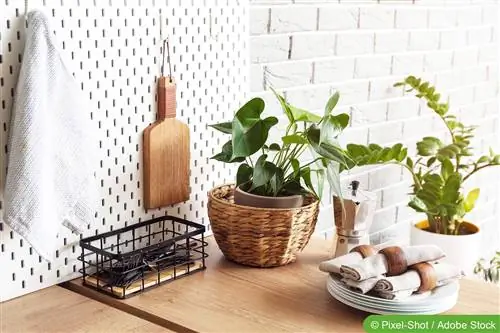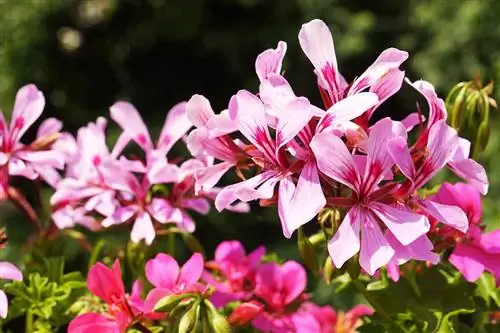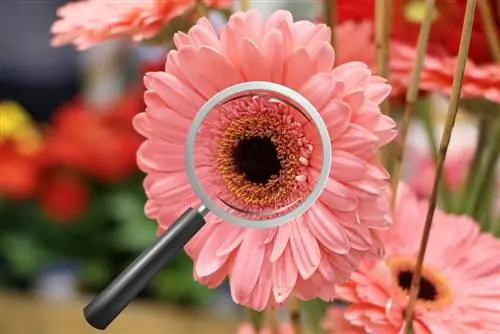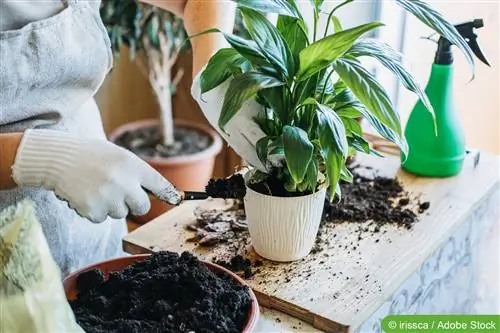- Author admin [email protected].
- Public 2023-12-17 03:39.
- Last modified 2025-01-24 12:45.
Houseplants for the kitchen should not be too delicate and lush, because the climate here is quite humid and warm. Accordingly, you should choose plants that like exactly that. The selection of appropriate green and flowering plants is quite large. What no kitchen should be without, especially in winter, are fresh herbs. They create a natural flair and not only give dishes the finishing touch, but often also exude a very pleasant and appetizing scent.
Bubikopfchen (Soleirolia soleirolii)
The Bubiköpfchen grows perennially, evergreen and creeping. It forms thread-thin shoots up to 25 cm long with countless small green leaves. You can shorten it at any time, cut it into shape or just give it a new hairstyle. The little boy can stand in bright and partially shaded areas, but not in full sun.
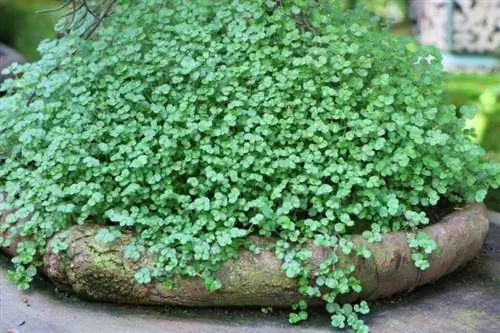
The substrate should be evenly moist all year round; waterlogging is poorly tolerated, especially in cool temperatures. Temperatures between 18 and 24 °C are ideal, summer and winter. Commercial potting soil is suitable as a substrate. From autumn to spring, fertilization is carried out every 2 weeks with a low-dose liquid fertilizer.
Flaming Kat (Kalanchoe)
The Flaming Käthchen, also known as Kalanchoe, is one of the thick-leaved plants and, depending on the variety, can grow up to 30 cm high. They are usually succulent perennial species with sawn, toothed or notched, and rarely even smooth, leaf edges. The green foliage contrasts beautifully with the many-flowered white, yellow, pink, orange or red inflorescences. This plant loves bright locations without direct sun and slightly cooler temperatures around 15 °C in winter. The substrate should always be slightly moist. The cooler the location, the less watering needs to be done. From April to August, a low-dose liquid fertilizer can be administered every 2 weeks. To prevent pests, it is advisable to spray the plants with water more often.
Tip:
If you have problems getting the Flaming Käthchen to bloom, you can support the flower formation by briefly darkening it. To do this, from autumn onwards, place a cardboard box over the plant for 12-14 hours in the early evening for several days. This is repeated until buds appear and the flower color becomes visible.
Edellieschen (Impatiens neuguinea)
Characteristic of the Edellieschen are its bright white, pink, orange-red, red or magenta-colored flowers, which stand out clearly from the shiny, dark green foliage. It grows upright and bushy, reaches 30-40 cm high and flowers from May to October. The Edellieschen is a cultivated form of the Busy Lieschen and one of the few houseplants that thrive in shady to semi-shady locations. The substrate should be permeable, fresh, humus-rich and evenly moist and waterlogging should be avoided. Fertilize from March to September every 2 weeks with a liquid fertilizer or a suitable long-term fertilizer. If withered flowers are removed regularly, this stimulates the plant's willingness to bloom. In winter the temperatures should be between 15 and 18 °C, watered less and not fertilized.
Single leaf (Spathiphyllum)
- The single leaf from the arum family can reach a height of 20-120 cm depending on the species.
- The special thing about this plant are the long-stemmed, distinctive flowers.
- Each large white bract encloses an upright white or greenish flower spadix.
- The location should be bright without direct sun.
- You water regularly and allow the top layer of substrate to dry a little in between.
- When temperatures are cooler in winter, less watering is required.
- The temperatures in winter should not fall below 16 °C.
- For optimal humidity, spray the plant with low-lime water every now and then.
- In spring and summer we fertilize every 14 days.
Tip:
Fertilizer should always be applied to moist substrate after watering, as the single leaf is very sensitive to s alt.
Dwarf pepper (Peperomia)
Dwarf pepper species are herbaceous, low-growing plants that differ in the shape, color and structure of the leaves and reach heights of up to 30 cm. The fleshy leaves and thin white flower spikes are typical. It prefers a humid and warm climate, making it the perfect houseplant for the kitchen. Variegated varieties thrive best in sunny and green, semi-shaded places at room temperature. The higher the white or yellow content in the leaves, the lighter the dwarf pepper should be. In winter temperatures should not fall below 15°C. Watering is only carried out when the substrate has dried thoroughly. Fertilize every 14 days from March to July.
Indoor Ferns
House ferns are among the most decorative house plants. The formation and coloring of the more or less delicate leaves are varied. The fact that they love warmth and require high humidity makes them ideal for keeping in the bathroom and kitchen. They love bright locations without direct sunlight. An optimal water supply and high humidity are important. The soil must neither dry out nor be wet with dew. Ideally, it should be watered with lime-free water and fertilized with a green plant fertilizer every two weeks from spring to autumn.
Tip:
For high humidity, the plants can be sprayed, a bowl of water can be set up, or the plant and pot can be placed in a larger pot and the space in between can be filled with moist expanded clay.
Herbs
Basically, herbs are better off outdoors. If this is not possible, they can also be cultivated in the kitchen. This has the advantage that you can harvest them fresh even in winter. They also have a decorative aspect, for example in herb pots with several levels, which also save space. The selection of herbs depends on your personal needs. Rosemary, thyme, parsley, chives and basil are most commonly used in the kitchen. Good drainage is important for all herbs.
Woody herbs such as rosemary or thyme require a bright, sunny place, whereas non-woody herbs such as parsley and chives require less light orPartial shade can be tolerated. The soil should neither dry out nor be permanently wet. Often, herbs are watered too much and they rot. Regular harvesting of shoot tips or entire shoots also serves as maintenance. If there is baldness, more severe pruning is advisable. To ensure even growth, you should rotate the plants every now and then. You can use low-phosphate fertilizers for fertilizing.
Tip:
Herbs that are sold in pots in supermarkets usually do not have a long lifespan because they are bred to be consumed quickly. Either you sow them yourself or immediately repot them in high-quality herb soil. After that, you shouldn't harvest for about three months so that the plant can grow and form new leaves.
What you should consider when choosing a location
Kitchens usually appear relatively cool, which can be quickly changed with plants. Houseplants in the kitchen freshen the air, create coziness and add accents, provided they are placed correctly. When choosing a location, it is important that you do not place the plants near the kitchen stove or next to fruit bowls, because fruits such as apples and pears emit a ripening gas, which causes the plants to bloom faster but also causes them to wilt prematurely. A place on the windowsill, on a shelf or in a hanging basket is more recommended.
Conclusion of the editors
Nobody has to go without fresh greens in the kitchen either. However, not all plants are suitable for the kitchen. Here too, they need a minimum of brightness, sometimes even sun, and have to cope with humidity and fluctuating temperatures.
What you should know about kitchen plants in brief
Spice Colors
Saffron yellow and paprika red: Gerbera flowers are the icing on the cake when it comes to fresh colors in the kitchen. It's no coincidence that they are drawn there, because gerberas love it warm and bright. In contrast to cut flowers, the small potted plants are less well known, although they bloom intensively for a long time. Water moderately but regularly.
Location for kitchen plants
Always place plants near the window and not directly next to or above the stove because of the kitchen fumes. Flowering potted plants should also not be placed next to the fruit bowl with apples: since the fruits spread ethylene, flowers wilt more quickly. A practical and at the same time decorative kitchen decoration are dried herb bouquets that can be hung up to hand and harvested leaf by leaf for cooking.
Herb corner for the kitchen
If you don't have a garden, you don't have to go without fresh herbs: rosemary, basil, chives and thyme also last quite well in a bright window seat for some time.
Popular kitchen plants
- Flamingo flower: valuable potted plants and cut flowers. They love a sunny to partially shaded location and temperatures between 18 and 24 °C. If the bale humidity is moderate, this can drop to 12 °C for a short time. Flamingo flowers should never be completely dry, but good drainage is necessary. If the humidity is too low, the plants should be sprayed more often.
- Bubiköpfchen: Small ground cover for bottle gardens or as a pot plant for cool rooms, also for double windows facing north. They grow best in partial shade. Care can be cool or warm, from frost-free to over 20 °C. Uniform humidity must always be maintained. Water can also occasionally stand in the base, especially in a warm room.
Kitchen plants and indoor climate
- They humidify the air: irrigation water is evaporated by the leaves and absorbed into the room air. The pleasant, moist air is good for the eyes, skin and respiratory tract. Strong water evaporators are linden tree, Cyprus grass and ornamental banana.
- Oxygen in exchange: Plants use carbon dioxide from the used air and supply oxygen in return.
- Pollutants are neutralized: Laboratory studies show that spider plants, spider plants, drazene or ivy can break down chemicals that pollute indoor air.
- Green lungs as dust filters: Plants with many small or heavily pinnate leaves, such as birch figs, ornamental asparagus or ferns, like to act as vacuum cleaners.

